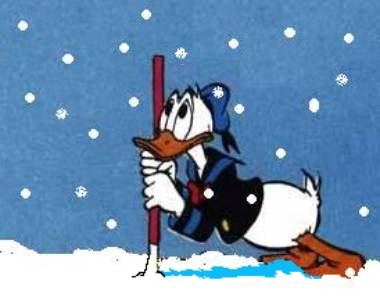
Sydnordisk
Akademi for Donaldisme - Institut for Donaldistisk Fysik & Geografi
by Dr.don. Jeronimus Gjøgsig, Duckburg Climate Conference in Copenhagen 2009

Weather is very important.
Even though we often complain about it, it is always a good topic for
conversation if anything else fails at boring dinner parties or at the bus stop.
And it is quite difficult to imagine a world without weather. This also goes for
the world of Stella anatium. Although the weather in most duckumentaries from
our Anatide parallel universe seems rather “neutral”, that is a mildly
tempered one with a blue sky, rapid changes do occur, often causing significant
disturbances in the events, sometimes even of catastrophic dimensions.
Historiography
of Academic-Donaldistic climatology
Naturally, the climate of
Duckburg soon came on the agenda of Donaldistic scholars when the whole school
took a scientific turn in the 1970s. As in the case of many other essential
Donaldistic study areas, the pioneers of Duckburg weather observations came from
Norway. In the two very first issues of the highly recognized journal of
Donaldism, Donaldisten, one of the
early school’s leading scholars, Pål Jensen, accounted for several remarkable
phenomena regarding the weather of Duckburg. For instance, clouds are hardly
ever seen on the sky over Duckburg (except around sunset and during actual
storms), it is never calm during rain (rain drops always fall obliquely), and
tornadoes occur relatively often.[1]

Jensen also pointed out
that tornadoes and storms in general are more common in the vicinity of Duckburg
than in the city itself. This he found to be in coherence with the Cosmos/Chaos-theory
of his compatriot colleague, Jon Gisle, according to whom cosmos of Duckburg is
constantly threatened by four types of chaos: 1. Witches; 2. Foreigners; 3.
Criminals; and 4. Forces of Nature.[2]

Duckburg climatology also took a
central role right from the beginning of organized German Donaldism, as it
became one of the four official initial research areas, when D.O.N.A.L.D. (Deutsche
Organisation der Nichtkommerziellen Anhänger des Lauteren Donaldismus)
was formally established in late October 1976.[3] Some might say that this
central inclusion of climatology partly had to do with the fact that the
founding meeting took place in the home of meteorologist Hans von Storch, but
that would be a complete misunderstanding: Duckburg climatology was of course
only included because of its essential importance for Donaldistic research in
general!
The important part of climatology
for overall Donaldistic studies soon became evident, as Duckburg weather was one
of the central elements of the
first (and perhaps only) major scholarly dispute between Norwegian and German
Donaldism, represented by its two leading figures, Pål Jensen and Hans von
Storch. Meteorological observations from Barksistic duckumentaries were used to
help identifying the geographical location of Duckburg on the North-American
continent. I will refrain from referring the entire discussion here and just
conclude that no consensus was reached.[4]
In short, it was debated whether
weather (sorry!) conditions observed in the Donaldistic source material could
fit with any of the suggested locations along the North-American coastline. Here,
von Storch found that the apparently rather harsh Duckburg winters were
difficult to match with Jensen’s proposed locations of Duckburg in Southern
California or along the Gulf of Mexico.
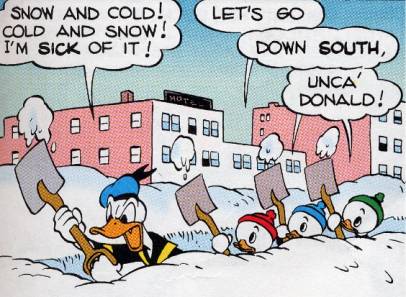
This
all very scientific discourse, which is a classic example of true Academic
Donaldism,[5]
took place in 1977, but already the year after, a change of
paradigm had made the whole discussion a bit superfluous, as scholars in the
meantime had realized that Duckburg is not situated anywhere on our planet Earth,
but should be looked for at a somewhat similar planet in a parallel universe; a
planet, which scholars poetically named Stella anatium.
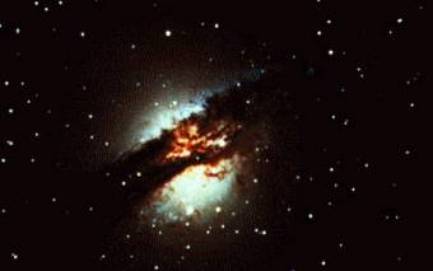
Once again, climatological observations had paved the
way to this essential recognition. Using good old German virtues of thoroughness
and scientific approach, Hans von Storch compared satellite pictures of Earth
with pictures from space of the Duck planet, which led to the shocking but
inevitable conclusion: The planets are not
identical!


The formation of clouds known from Earth cannot be
found around Stella anatium. In addition to this, in the German version of the
tale of the cold-sensitive frog Catapult (Da.: Badutski), Donald speaks of a
“cold front breakdown”, which according to von Storch would be a down right
ridiculous statement to make on Earth, where the correct meteorological term for
the said weather phenomenon is “occlusion”. Von Storch realized that critics
were inclined to put it against him that perhaps Donald was not altogether
familiar with proper meteorological terminology and thus had fallen for the
temptation of using a more layman-like term. Such a counter-argument was,
however, rejected in advance by the German scholar as completely groundless, as
Donald on numerous duckumented occasions has proven himself a very competent
meteorologist. Therefore, the “cold front breakdown” had to be an actual,
extra-terrestrial weather phenomenon.
The ground-breaking recognition of Hans von Storch was
presented in one of the still classical and basic works of our school, “Klima
in Entenhausen”, published in the highly recognized Donaldistic journal Der
Hamburger Donaldist vol. 13 (1978). Another major result presented in this
essential work was the realization that the second law of thermodynamics does
not apply in Duckburg. A weather-related example of this is given by Mr. Duck
himself, who during his occupation as flying rain-maker has a machine in his
aircraft capable of creating snow storms in the middle of summer.
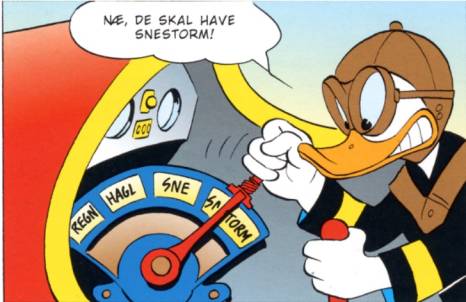
Such a task demands an enormous amount of kinetic energy: »Daß er diese Bewegungsenergie nicht in seiner Thermoskanne mit sich führen kann, ist klar.« The only explanation left, according to von Storch, therefore had to be that Donald Duck’s machine can extract the energy necessary to cool down the air from the air itself. Something which cannot be done on Earth - probably not even in our universe.
Meteorological observations from Duckburg and Stella anatium
Having passed the
school’s early attempts to compare
weather in Duckburg with weather found in various North-American zones on Planet
Earth, Donaldistic scholars are now back to studying Duckburg climatology on its
own premises. And, so, how is weather in Duckburg? Well, as initially stated,
usually quite good. For someone like myself, living in the Southnordic region of
Terra homines, it is hard not to look
with some envy on the apparently vast majority of fine-weather days in Duckburg
with blue sky, mild temperature (where you can walk around in a sailor shirt and
no pants) and almost no wind.
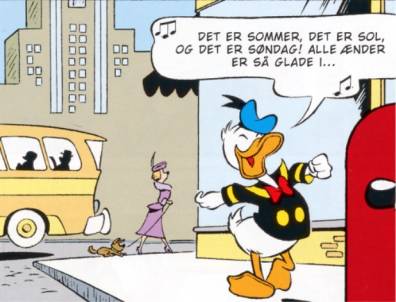
However, all this gentle peace and calm can suddenly
change. A warning sign of such a change can be detected by the use of a
barometer.

In spite of Donald’s sailor outfit, his somewhat
ignorant response to the nephews’ observation (»The barometer has fallen, Uncle!« »Then pick it up! I’ve got other things to do!«) does leave some
doubt about Dr. Hans von Storch’s abovementioned appraisal of Mr. Duck’s
meteorological awareness. His (that is Mr. Duck’s) older and wiser relative,
Uncle Scrooge, shows a significantly better insight to meteorological warnings.

A sudden fall of the barometer means that a storm is
ahead. And storms on Duck Planet are often synonymous with tornadoes. Tornadoes
in and outside Duckburg can arise very suddenly and with an impressive power,
even if only on a surprisingly local scale - and sometimes with an even more
surprising accuracy in the caused effects.

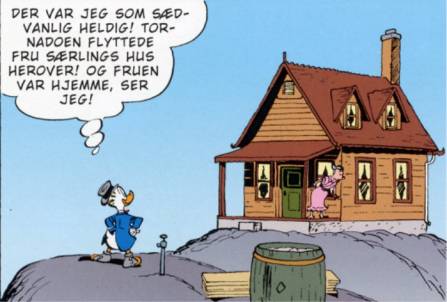
Tornadoes in Stella anatium occur in very different
sizes. Some of them reaching far out into the atmosphere..
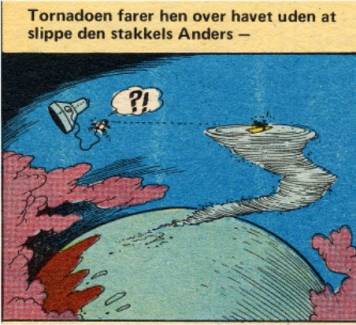
…while
others are quite small.
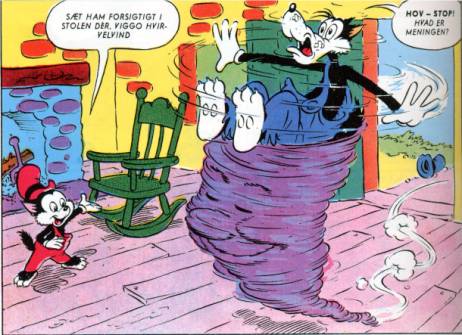
Moreover, wind
and tornadoes in Stella anatium differ from the ones known on Earth by the fact
that some of them actually “are alive”, that is, they have a mind, a face
and the ability to speak!
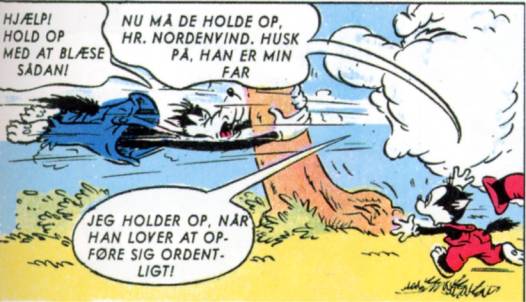
Finally, tornadoes are known to have produced vital changes in the basic economical structure of Duckburg - at least for a time.

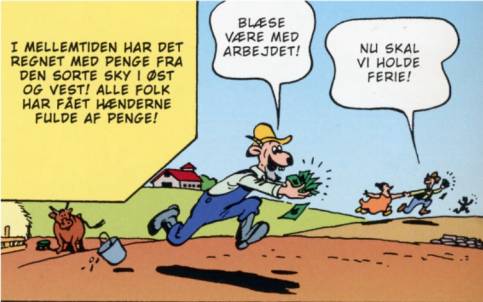
In fact, such a seemingly connection between large monetary quantities and air temperature, and thus wind movements, has been observed in Duckburg on more than one occasion.

Too my knowledge, nothing similar has ever been seen
around even the largest banks or gold deposits in our world, but then again, the
monetary mass in Duckburg is
exceptional.
In spite of the sudden and apparently unpredictable
behaviour of wind in Duckburg, the weather forecasts are impressively accurate.
The forecasts presented in the radio even informs of wind speed in 300 metres
altitude - an appreciated information for the city’s giant-kite flyers.
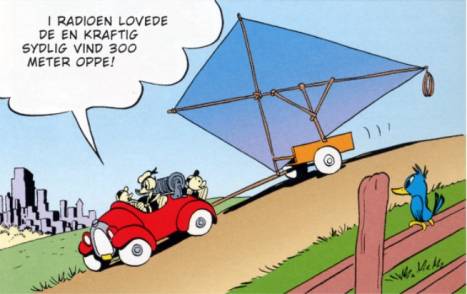
Such an accuracy appears even more impressive, when one
takes a closer look on Duckburg’s meteorological profession’s
professionalism.
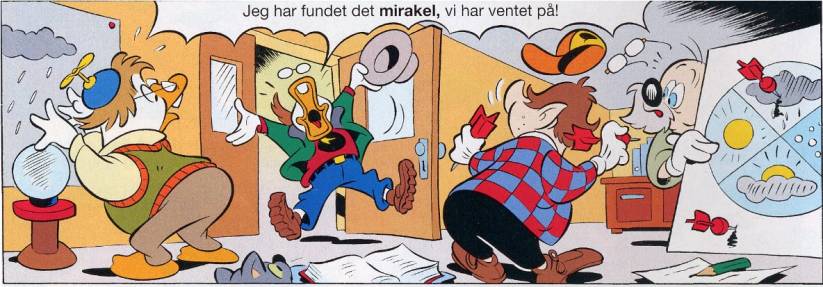
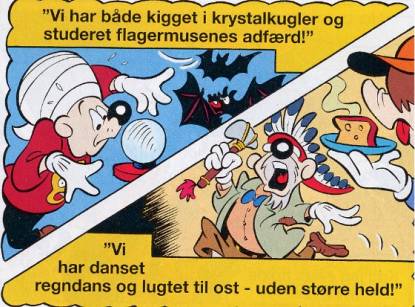
The
forecasting methods apparently include scientific tools such as darts, crystal
balls, bat-behaviour studies, rain-dancing and, of course, smelling of cheese.
Not to mention licking the neck of a cat to determine the coming weather from
its purring.
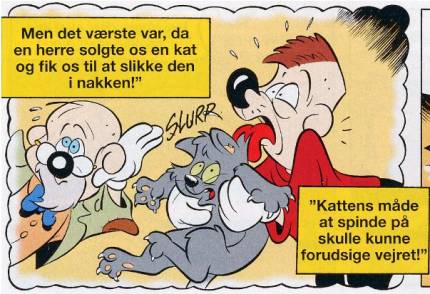
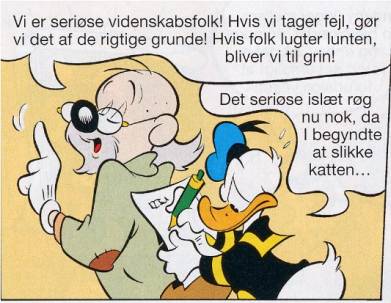
Whatever can be said about the serious appearance of
such methods, it cannot be denied that they seem to work. Therefore, taking into
account the general accuracy of weather forecasts in our part of the world,
these were perhaps methods worth suggesting to Southnordic meteorologists as
well?
Even meteorologists of more alternative status in
Duckburg can be strikingly precise and accurate in their predictions.
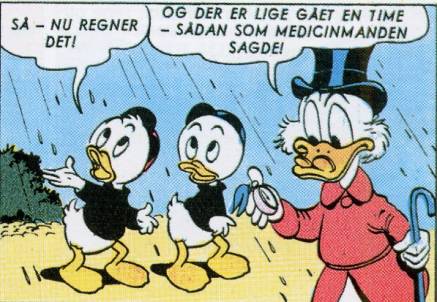
However, in this particular case the successful weather
forecast is based on more than just excellent foretelling skills (including
rain-dancing and licking cats in the neck). In Duckburg, meteorological experts
are not limited to just predicting the weather - they can actually make weather!

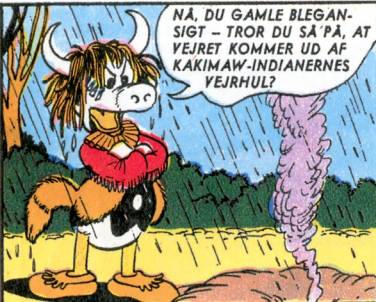
Especially rain-making is a wellknown practise among the Ducks, which can be performed both from the ground (above) and from the sky (below).
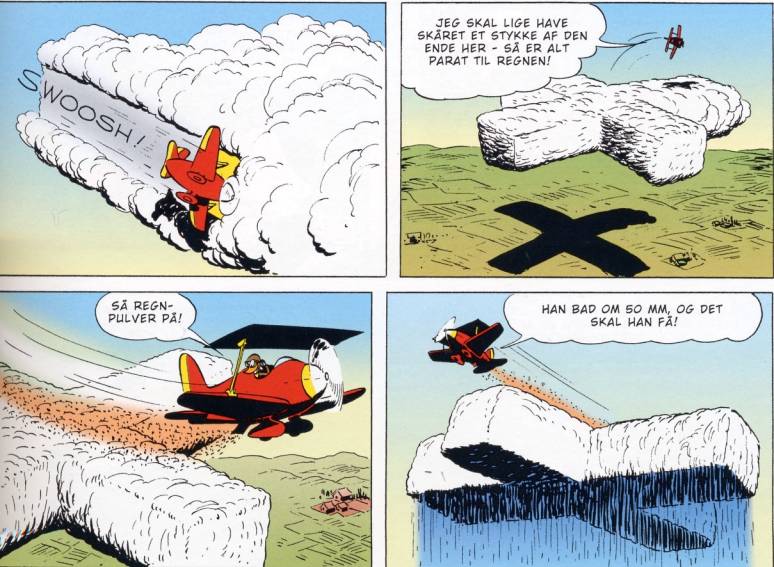
Duckburg weather making is eased by a number of
advanced chemical, physical and mechanical tools. In both abovementioned cases,
the essential additional ingredient is rainpowder, which apparently is
marketed in several registered brands, such as AJAX™ and M-3™.
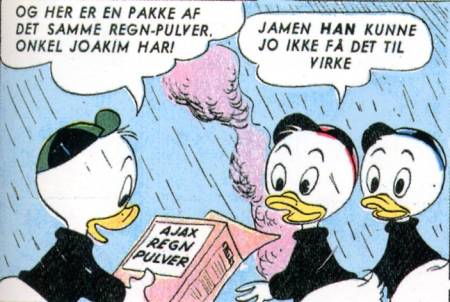


And for making snow, the true professional always has a
sack of SNOWSTARTER™ ready at hand.

But in fact, just like on Earth, it is usually also
possible to provoke rain by much simpler methods, such as hanging out the
laundry to dry...
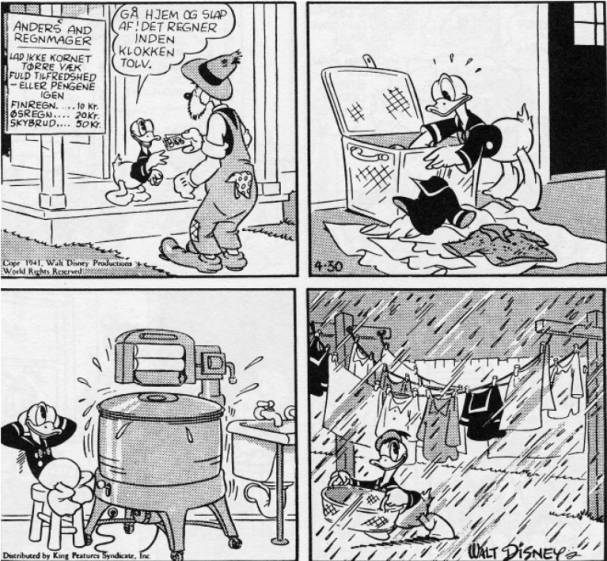
..or going on a picnic.
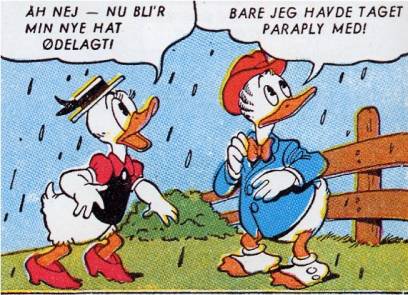
The relatively rare rain in Duckburg could, at first
hand, seem to lead to rather exaggerated panicking among the public, even at
what otherwise appears only to be rather light showers.
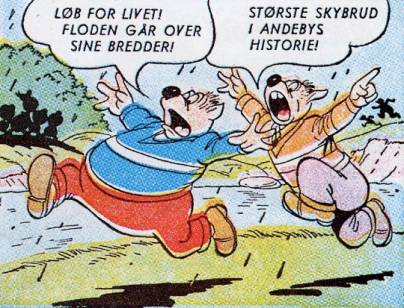
However, that would be a hasty and unjust
misinterpretation, grossly underrating the meteorological understanding of the
Duckburgians. In fact, the apparent “shower” over Picnic Wood, presented
above, turns out to be a peripheral skirmish of a terrific cloudburst, which
only seconds after causes a huge tidal wave and accompanying flooding.
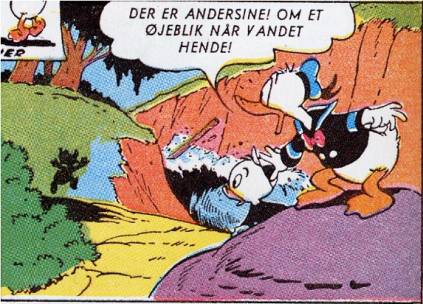
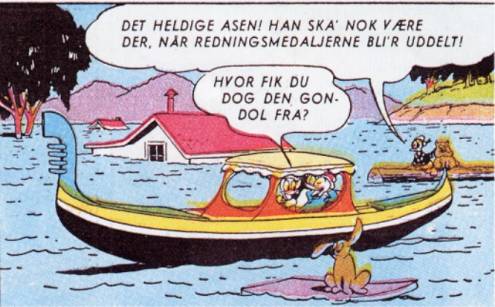
Thus, even short light showers are not something to be
sneezed at in Duckburg and its vicinity. And neither are the well-founded
warning cries of the Duckburgians.
The major flooding threats against Duckburg do, however,
not come from the rivers and the city’s
hinterland, but from the seaside. One of
the greatest floodings in Duckburg’s recent history was named ‘Pluvius’.
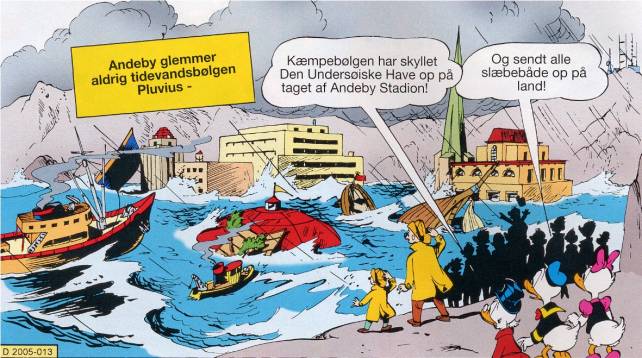
Fortunately, also at this occasion Duckburg’s
meteorological warning system showed its worth once again...

..even if
“warned just in time” apparently just means “warned early enough to climb
up the nearest lamp post”.
An evidence of
the extreme size and force of this particular tidal wave is given in the fact
that stranded whales subsequently could be found in the surrounding hills.
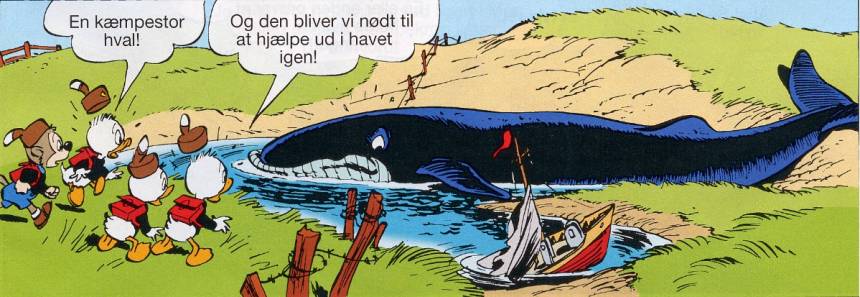
Although
picnics in general seem to have a rain-evoking effect when urban Duckburgians
decide to visit the surrounding woodlands, the Wood normally appears to have an
extremely dry micro climate. My esteemed colleague, Professor Jakobsen, dean of
the Academy’s Faculty of Bearology, has found that it hardly ever rains at all
in duckumentaries from the Wood.[6] In spite of this lack of rain, the Wood
mainly consists of deciduous trees - with smaller elements of conifer, which has
a peculiar tendency to appear especially around christmas. Strangely enough, the
dry climate never seems to threaten the Wood with drought - or drought-related
fires, for that matter, although this may be due to the existence of a most
alert corps of voluntary fire fighters.

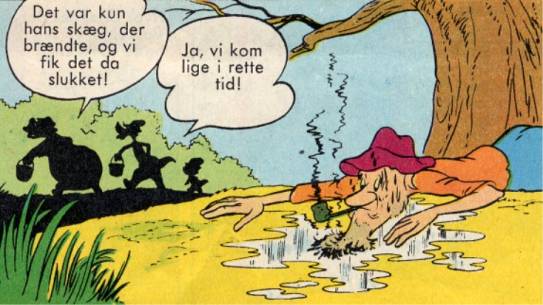
As a possible reason for the apparently favourable growing
conditions in spite of the limited precipitation, Professor Jakobsen suggests a
very high level of subsoil water.
Precipition almost only occurs in the Wood during winter as
snowfall. Among other things, the fall of snow serves as a very practical and
important signal for the Bears to start the annual winter lair.
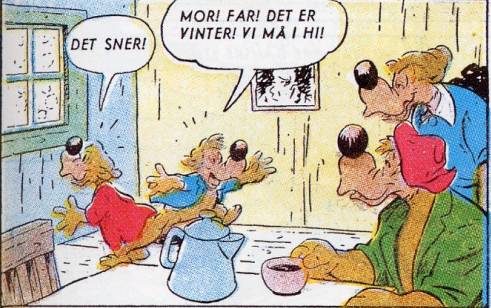
In fact, even just a few snow flakes in the Wood are known to provoke an astounding hibernating response with the Bears.

Therefore, according to Jakobsen, winters without snowfall can
be feared to have an utmost disturbing effect on the Bears’
sleeping pattern -
with an equally negative effect on their spirits. Fortunately, to judge from the
duckumentaries, snow seems to be rather certain in the Woods from early December
to late January.
The same goes for Duckburg itself. Despite the generally quite
mild climate all year round, which enables the growth of palm trees…
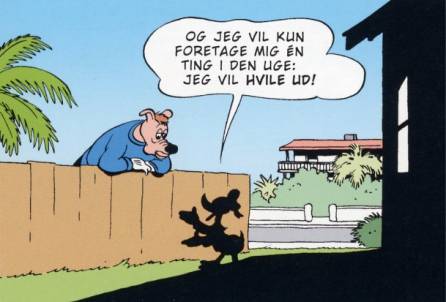
..also Duckburg every now and then experiences
amazingly severe winters with hard frost...
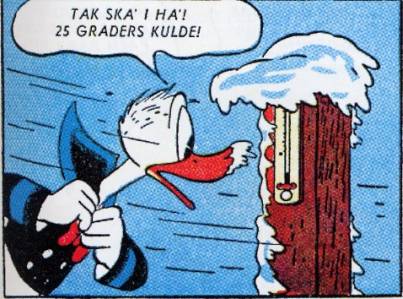
..and impressive masses of snow.

According to the elder generation, this is, however,
nothing compared to the blizzards in their
childhood.
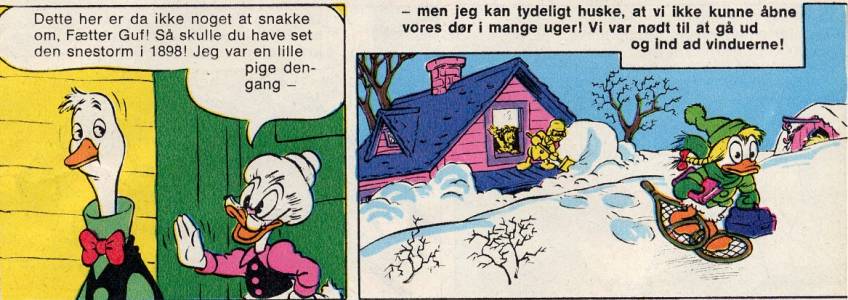
Conversely,
Duckburg summers can produce shorter intervals with extreme heat.

Whereas even the most extreme sides of Duckburg weather
can be found on our planet as well,[7]
Stella anatium outside of its Anatide
metropole has a number of quite unique and extra-terrestrial weather phenomena.
Such as in Rainbow Valley, where several rainbows always occur simultaneously!
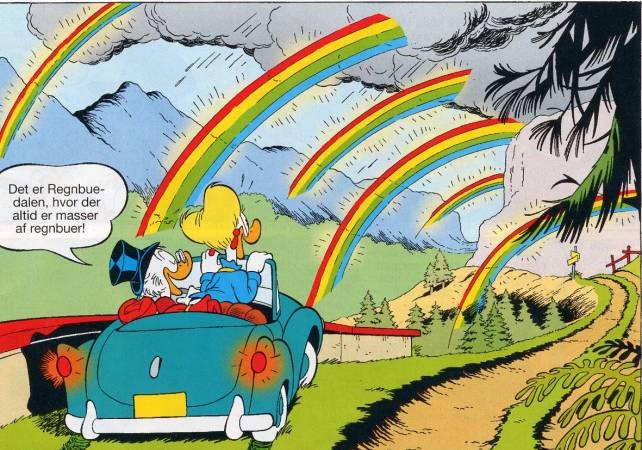
A meteorological-optical phenomenon, which according to
my inquiry with the Danish Meteorological Institute has never been recorded in
Southnordic latitudes, at least not within the institute’s lifetime.
Another peculiar and from Planet Earth rather deviant
phenomenon on Stella anatium is that the Anatide version of Alaska has a
tropical micro climate, where the otherwise quite cold air of the region is
warmed up to a tropical level by hot volcanic springs...

..some of them even in the shape of geysers spouting
liquid gold.
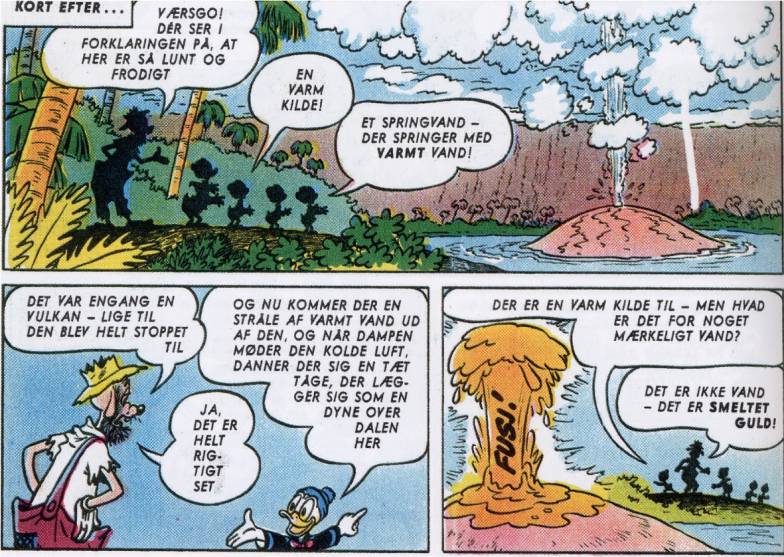
It is, however, still a matter of scholarly debate
whether Mr. Duck’s claimed discovery of banana palm trees on the North Pole of
Stella anatium is to be taken at face value, or if it rather says something
about Mr. Duck’s aero-navigational qualifications.[8]
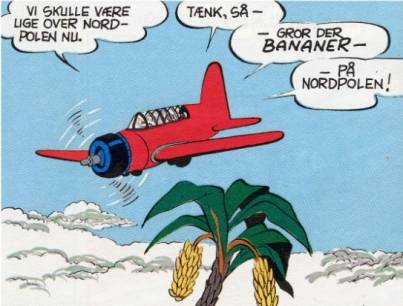
Climate changes in Stella anatium?
Now, as you all know, in these very minutes, where I
share with you my limited knowledge on wind and weather in Duckburg and Stella
anatium, a few kilometres away, the top climatologists of the world are meeting
here in Copenhagen to discuss climate changes on Planet Earth. Which inevitable
leads us to the obvious question: Is the
climate (also?) changing in
Duckburg and Stella anatium?
Well, according to Grandma Duck, as stated above,
everything has grown softer since her childhood, including the winters. Serious
scientists should, however, be careful not to put too much emphasis on such statements, as there seems to be a common
tendency that old people everywhere and throughout times have claimed such a
softness and laxity in present times compared to the good old days. A claim,
which cannot always be confirmed by studies of more objective sources.
Actually, we have a completely opposing perception by a
Duck Viking, who was defrosted in 2007, only to find that the world had grown
significantly colder.
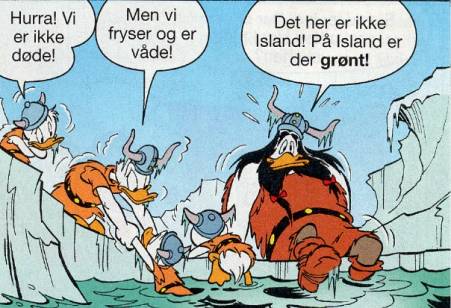
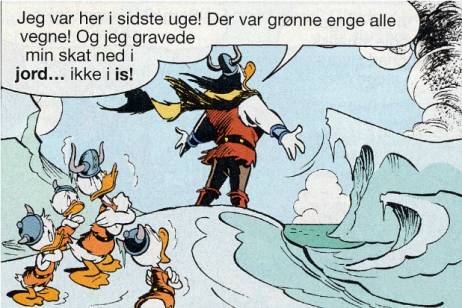
Apparently,
this would indicate that the climate has
changed on Stella anatium within the 1000 years-span from the Viking Age till
today. But how about climate changes on a shorter term? Have the weather in
Duckburg changed systematically since we received the first duckumentaries from
there in the late 1940s? One of our esteemed key note speakers here at the
Duckburg Climate Conference of Copenhagen 2009, Professor Dr. John Thomas
Airhead from the University of Calisota, has studied this important question
thoroughly, and we are all very excited to learn about his findings shortly.
I will, however, close my modest contribution to this conference with the conclusion that weather and climatology certainly are worth studying, not least in Duckburg, where the quoted works of the early masters Jensen and von Storch hopefully will inspire a new generation of Donaldists for the future. Furthermore, we can conclude that the old saying of the Danish philosopher Storm(sic!) P. that “Everybody speaks about the weather, but no one does anything about it!” only applies for Earth - in Duckburg, they actually can do something about it.

Although
I am not quite sure whether this is a technology that we should necessarily wish
to imitate...
Notes:
[1]
Jensen 1973-74.
[2]
Gisle 1973, 118.
[3]
The four chosen research areas were: 1. The Veronkelung-system;
2. Socio-economical structures of society; 3. Aesthetics in Early Donaldism; and
4. Climate in Duckburg. Der Hamburger
Donaldist vol. 3, 1.
[4]
The debate is reproduced in Der Hamburger Donaldist vol. 4, 19-20. A Danish summary has been
given by myself at an earlier occasion (Gjøgsig
2006).
[5]
That is taking a tiny and apparently insignificant Donaldistic detail and
blowing it up to what could be termed “Academic-Donaldistic proportions”,
studying it from a most scientific approach and
then have a long and pugnacious discussion about it with fellow scholars,
which in the end leads to greater uncertainty than existed to begin with.
[6]
Jakobsen 2006.
[7] With the antropomorph North Wind as a possible exception.
[8]
GrandjeAnd
2004.
Abbreviations
for duckumentary sources (occur when cursor is put upon
picture):
|
|
Bibliography:
Gisle, Jon (1973): Donaldismen,
Oslo.
Gjøgsig, Jeronimus (2006):
Klima
i Andeby - og Stella anatium, Sydnordisk Akademi for
Donaldisme.
GrandjeAnd, Jacobinus (2004):
Supplerende
andtropologiske bidrag om sortænderne på Stella anatium, Center for
Klassisk Donaldisme, SAD.
Jakobsen,
J.G.G. (2006): Klimaforhold
i Skoven
(svar på seminarindlæg), Sydnordisk Akademi for
Donaldisme.
Jensen, Pål (1973-74): “Andebys
klimatiske forhold”, articles in: Donaldisten vol. 1-2, 7-9 and 21-22
resp.
Jensen,
Pål, Uwe Schröder & Hans
von Storch (1977): “Wo liegt Entenhausen”, in: Der Hamburger Donaldist
vol. 4, 19-20.
von Storch, Hans (1978): “Klima in Entenhausen - Physikalische Grundlagen”, in: Der Hamburger Donaldist vol. 13, 10-13.
Sydnordisk Akademi for Donaldisme henleder opmærksomheden på, at rettighederne til (næsten) alle de anvendte billeder på Akademiets sider tilhører ©Disney, der i Danmark er repræsenteret ved Egmont Serieforlaget A/S. Billedmaterialet må ikke anvendes i erhvervsmæssigt øjemed.